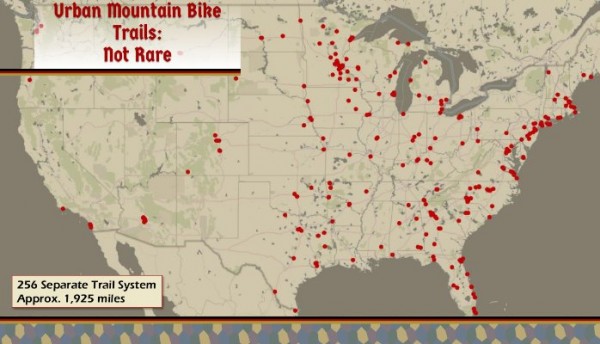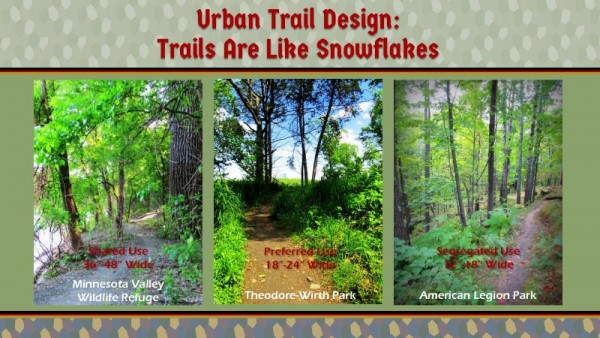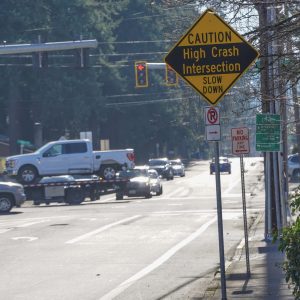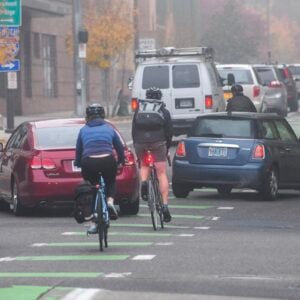 Every dot is a urban mountain biking trails system[/caption]
Every dot is a urban mountain biking trails system[/caption]
This post was written by Joshua Rebannack and it’s based on the “Knobbies in the Neighborhood” presentation he recently gave in Portland.
The issue of urban mountain biking has been one that made its rounds through the halls of government at Portland multiple times in past decade. But regardless of the property, the conditions, or the proposal, the result has been the same: mountain bikers are promised trail mileage, that “this time will be different”, only to end up with nothing at the end of the process.
Into this history comes “Knobbies in the Neighborhood”, which I presented on March 17th, 2016 to those in attendance at the Multnomah Athletic Club (MAC). What does it have to say about urban mountain biking? How can it inform Portland’s Off Road Cycling Master Planning process?
The first section of “Knobbies in the Neighborhood” considers the state of urban mountain biking across the whole country. As of last count there are 256 individual urban mountain biking trail systems comprising 1,925 miles of trail in cities across the nation. From New York City to Tacoma, from Miami to Duluth, urban mountain biking has found a home. Whether they be in parks, urban wildernesses or federal wildlife management areas they have been a success wherever they are. These trails aren’t new either, spanning nearly a quarter century of time.
So why would looking at existing urban mountain biking trails help Portland? Firstly, it provides a source of knowledge that Portland can draw from. Seeing that Portland is one of the few major cities without urban mountain biking helps frame the process as, “How do we…?” Recognizing that other cities have had urban mountain biking for decades also instills a confidence that urban mountain biking can work over the long haul.
The second section of “Knobbies in the Neighborhood” goes through the process that we, as mountain bikers, as sustainable trail designers & builders, go through to avoid ecological impacts. In Portland, the belief that mountain bikes on trails cause more impacts than hiking has been the sticking point in the past. Some of this is just a misunderstanding of how modern trails are built and maintained. Some of this is, unfortunately, intentional misinformation from individuals and groups who dislike mountain biking.
Did you know, for instance, that the current sustainable trail guidelines of the United States Forest Service (USFS) were created by mountain bikers? Or that sustainable trails are built the same, regardless of the primary user group? Lastly, did you know as part of the design process for sustainable trails that biologists, geologists and historians or sociologists are involved in determining the layout of the trails?
All these discussions are important, especially for Portland. Everything we do as humans has an impact on nature, whether it be hiking or mountain biking. The real discussion that needs to be had is what level of impacts Portland is willing to accept, whether from boots or tires. Sadly, many of the same individuals and groups leading the charge against urban mountain biking encourage activities that have impacts far in excess of what mountain biker groups would ever be comfortable with, even suggesting that creating erosional conditions is ‘fun’ (see this recent tweet by the Forest Park Conservancy). Seeing the processes we as mountain bikers go thru to prevent ecological impacts helps refocus the debate on what matters: the real impacts to vegetation and soil from all users.
The last major section of “Knobbies in the Neighborhood” focuses on how to create trails that are safe for everyone. More than any section, it leans heavily on the lessons of those cities that have urban mountain biking. There is a real fear that putting mountain bikes on the same trail as hikers will cause issues or injuries. It’s not an illogical fear. However, it’s a fear based on not knowing how other cities have solved this problem.
Other cities have various methodologies to control how the public use the trails to prevent negative interactions. One of the most common method is something called “directionality”. Directionality is defining the direction of travel on the trails. If we define a direction of travel for trail users, we can also predict where issues might occur and find ways to avoid negative interactions. Often directionality is combined with other controls based on the volume of users on a trail. The more users, the tighter the controls. Those solutions could work for Portland also.
In the end, where do the lessons of “Knobbies in the Neighborhood” fit into Portland? Due to the way Portland is considering urban mountain biking, thru the Off Road Cycling Master Plan, those lessons are most applicable now, at the beginning of the process. Without understanding what others have done or are doing, Portland could end up with concepts and choices that were found to be substandard in other cities with no way of changing them without redoing the whole process. What’s concerning is that current materials for Off Road Cycling Master Plan excludes any lessons of, let alone any mention of, existing urban mountain biking systems. Citizens of Portland, especially mountain bikers, should be very concerned about a process that doesn’t even talk about the previous 25 years of experience with urban mountain biking.
All in all, giving “Knobbies in the Neighborhood” was a great experience and a lot of fun. I would like to thank the Northwest Trail Alliance for setting up the venue and invitations. I would like to thank all that attended. Hopefully, everyone went away understanding something new about urban mountain biking.
If you didn’t get a chance to come to see “Knobbies in the Neighborhood” all is not lost. I will be giving an encore presentation of the Portland specific version on April 3rd, 2016 via Google Hangouts at 6:30pm PST. To view the presentation, please send an email RSVP to joshua@cyclekrieg.33mail.com by 4:30pm PST on April 3rd to receive an invite to the Google Hangout.
– Joshua Rebannack









Thanks for reading.
BikePortland has served this community with independent community journalism since 2005. We rely on subscriptions from readers like you to survive. Your financial support is vital in keeping this valuable resource alive and well.
Please subscribe today to strengthen and expand our work.
Mountain biking is transportation. Many trails on public right-of-way in the burbs are poorly maintained, muddy, and mountain bikes work well on them.
Awesome work Joshua.
I sympathize that Portland doesn’t have any good mountain bike infrastructure. However, the map of cities with mountain bike parks includes many that use the parks as a substitute for any good on-street infrastructure. To give three examples I know from personal experience: Grand Forks ND (top center red dot near the Canadian border) has river trails and 47 miles of paved multi-use trails, but few bike lanes and no sharrows. Morgantown WV (red dot near Pennsylvania) has no bike lanes nor sharrows, but a rails-to-trail and an excellent technical single-track park. The city I now live in, Greensboro NC (one of a cluster of red dots in NC) has a mountain bike trail area in the wealthy white area of the northern suburbs, but few bike lanes, and is only now adding sharrows.
The point of the map was not to show on-street facilities, but urban mountain biking. You are right to point out Fargo is not going to win awards for cycling. No one would ever call Miami awesome for cycling either, but it has more single track than ALL of Portland.
I’m aware that the dots show cities with mountain bike facilities within their boundaries (Fargo is not one of the dots, which is reasonable, since it has no mountain bike facilities; GF, Jamestown, and Bismarck are shown, and do have facilities). My point is that many of these same cities use their designated mountain bike facility spending as a substitute for spending on badly-needed on-street facilities, which Portland excels in. And, yes, people in ND (and WV & NC) do in fact ride on city streets all year long, to commute to schools, jobs, and errands, and all wish they had what Portland has. Such cities use the expense for the mountain bike parks as an excuse to not spend any funds on on-street bikeways.
While every city and area funds mountain biking differently, please remember that off road cycling and on road cycling facilities almost always come from different pots of money. On road cycling facilities are often required to be paid for via property/sales tax (city streets), gas taxes (state roads) or some federal dollars through a DOT (Tiger). Off road cycling facilities are usually paid for out of park budgets or self-funded by mountain bikers. City budgets do not operate like personal checking accounts. Moving money between divisions within departments, let along between departments, is often legally difficult, if not impossible.
Also, what about cities like Minneapolis or Louisville (or New York City for that matter) that manage to do both?
p.s. You can do this in Chicago, but not Portland: https://vimeo.com/140269558
Personally I support all types of cycling; varieties inspire others to try other ways to get around. I agree that mountain biking has been historically underfunded (or not funded at all) in Portland. However, your article avoids the funding issue, will you cover that in a subsequent article?
In Portland, the parks budget comes from the general fund, same as housing, police and fire, paid with property taxes, the ULF, hotel taxes, licenses, etc. As you can see from previous posts, transportation in Portland is already severely under-funded, which locally comes from gas taxes, parking, vehicle registration, and a decreasing amount of Federal funding (Portland last got a TIGER grant over 10 years ago.)
My understanding is that a lot of trail work can be successfully done with a lot of donated labor and materials, and that the main costs are in land, legal agreements, utility provision (water, sewer, & electricity for toilets), and long-term maintenance, not to mention long-term political cooperation from elected officials (or avoiding betrayal).
I hope the mountain bike master plan will cover it (though I’m skeptical, knowing Portland politics), but for land, you might look into the many undeveloped Parks and BES “Hydroparks” in East Portland, specifically Gates (136th & Holgate), West Powellhurst (116th & Division), Halsey Hydropark (Halsey & 148th, across from Glendoveer), and Kelly Butte (between I-205 and 110th, and between Division and Powell. Of course, Gateway Green will fill a certain niche.
Fargo may not win any awards for transportation cycling, but Minneapolis does. It IS possible to have both.
In terms of transportation cycling, Minneapolis perennially challenges Portland for the #1 spot. Maybe a little (but only a little) behind central Portland in terms of on-street bike lanes, but comparable in terms of bike boulevards, and far ahead in terms of off-street pathways (often segregated from pedestrian traffic) adjacent to streets, and more mileage of on-street protected bike lanes too.
For mountain biking, we have thirteen mountain bike trail systems within the metro area. Of the 3 photos in the “Trails Are Like Snowflakes” graphic above, two (Theodore Wirth and Minnesota Valley) are in the Twin Cities. And in fact, those two are within 45 minutes biking (not driving!) of my home.
Duluth, not too far from here, is pretty good for on-street cycling too, by the way. They are off the charts for mountain biking, one of only six IMBA Gold Ride Centers on the planet. Something like 8 mountain bike trail systems, including significant slickrock on the Piedmont system, and much of the work is complete on the 100-mile Duluth Traverse following the ridge that runs the length of the city. In terms of hiker-biker coexistence, the 300-mile Superior Hiking Trail also runs through Duluth, often parallel to the Traverse.
“…many of the same individuals and groups leading the charge against urban mountain biking…” Joshua Rebannack
The objection widely held by Portland residents, I think, is not to urban mountain biking per se, within Portland city limits. The objection is to use of vehicle free natural land parks, for mountain biking.
Use of of bicycles and other vehicles on lands primarily designated for foot travel, dramatically changes the travel and experiential dynamic of those lands. It’s possible to create on natural land, very well engineered bike trail that minimizes environmental destruction. Doing so does not change the fact that such trail brings the vehicle dynamic to natural land.
If the “experiential dynamic” was the actual argument against urban mountain biking, honestly, there is no way to discuss that. Its a values based argument. Cities can’t make real decisions based on values because everyone’s values are somewhat different. I love kosher deli’s, for instance, but I wouldn’t expect or want the city to decide they should serve pork or other delis shouldn’t serve pork based my values or their values. Which set of values is correct? The same with arguments for or against mountain biking that are based on values.
What we as humans should care about is logic, science and history. If it is, as you say, “possible to create on natural land very well engineered bike trail that minimizes environmental destruction”, then what could be the logical, scientific or historical reason not to? Is better to alienate potential defenders and protectors of urban greenspaces vs. welcoming them into the fold? Its more logical to spurn volunteers that urban parks so desperately need? Is it more scientific to allow all manner of negative uses in a park with large impacts while refusing to acknowledge a group that a) drives out negative uses and b) can restore and rewild vast areas of public land?
Lastly, let’s look at the point of “use of of bicycles and other vehicles on lands primarily designated for foot travel, dramatically changes the travel and experiential dynamic of those lands.” What about Forest Park? This is a park where it’s currently legal to take bikes along Leif Erikson drive (equal to 136 miles of mountain bike trail impacts, BTW) or any fire road. If, again as you say, it’s possible to create trails that “minimize environmental destruction”, then how is the creation of, or use of, mountain biking trails affecting a location that already allows “vehicle” traffic? Even in a place like Riverview or Marquam how will it be greatly affected by a certain percentage of users traveling on those trails via a mountain bike if their speeds are similar to walking/jogging users and we maintain methods to allow them to share trails safely with said users?
Seriously, you should sign up for Sunday’s encore presentation, it might not be your “road to Damascus” moment, but it might be darn close…
What path or trail have you ever seen where cyclist speed is the same as walkers, or even joggers?
I’m having a hard time believing that you really proposed that as an actual possibility.
I’m not anti-mtb. In fact, before I moved here I regularly rode to singletrack from both my home and office. I just think that we should be realistic about the existence of the oblivious and inconsiderate in both camps. They only seem to co-exist well when cycling is the primary function and peds enter with an “at your own risk” mentality.
While I’m at it, calling some of those red dots urban is an enormous stretch. They’re about as urban as if you put in some trails out at Troutdale, Tualatin Hills, or Ridgefield.
Strava.com – Look at other urban mountain biking trail systems.
The 5 fastest people at most urban mountain biking at speeds around 10-13mph with the median speeds closer to 6-8mph. Those speeds are human achievable. In fact, trail runners (who generally like trails built for MTBers) tend to average speeds in the easily in the 6-11mph range.
As to the dots, here my methodology of trail systems to be added to the map:
1. Must be within the city limits of a municipality or managed (at least partially) by a city.
2. Must be at least 1 mile in length per MTBProject.com .
3. Must be accessible by bike or transit.
4. Must be 100% legal trails.
If you have any specific trails you have issue with, please let me know and we can discuss why you feel it should be removed.
Or you could join the Hangout tonight…
The Tualitan River National Wildlife Refuge invokes the most strict protection: no dogs; no jogging; no bicycles.
Nature likes that!
You would be surprised to learn what nature likes. I spent five solid minutes with two magnificent elk this afternoon while Mountain Biking in the Falls Creek area. They were as interested in me as I was with them. I did not harm any salmon, or trout, while riding in the forest either. I did have an outstanding day thanks to nature, my car, great scheduling and a Mountain Bike. Nature does not like development!!!
How does nature feel about twenty first graders? If I am hanging out on the front porch of my nest, or performing a mating ritual for my little lady, I might prefer the swifter, occasional passerby than someone gawking at me for long periods of time (possible eyeing me up for a meal).
Excellent write up. We can hope that the master plan process listens to history and uses best practices to establish mountain biking in Portland. We cannot continue to exclude mountain bikes from our parks.
Thank you for discussing this topic! When I moved from Philly to Portland a little over 10 years ago I thought I would have better access to mountain biking. I could not have been more wrong. Philly blows Portland out of the water in readily accessible singletrack. They aren’t even in the same universe…and that is sad.
Interesting there’s no dots on the map in northern CA. What you define as a City? San Francisco and Oakland both have cool if small mountain bike systems within the city. Some other bay area suburbs do too.
Outside the main urban areas, smaller cities like Chico have MTB in city parks. Then on to much smaller towns, consider South Lake Tahoe and Arcata. They have ‘big’ population for their local counties, but tiny in the real scheme of things.
The map is via MTBProject.com with municipality check via MapTechnica.com.
Requirements for the map:
1. Must be within the city limits of a municipality or managed (at least partially) by a city.
2. Must be at least 1 mile in length per MTBProject.com .
3. Must be accessible by bike or transit.
4. Must be 100% legal trails (so there goes all of Marin County, for instance, save for China Camp & Stafford Bike Park, but Stafford is not in a municipality).
Yeah, that excludes some like Palos Hills, in Chicago, which is an island of county land in a sea of municipalities, but this is presentation about URBAN mountain biking after all. Best to be conservative than open up the possibility something doesn’t qualify and get dinged for it.
I’m updating the map for 2016, so if you think there are some I’m missing (I will be adding China Camp and Wildcat Canyon because they are partially in municipal borders) please let me know.
MTBProject data is very lacking. Maybe add others; Trailforks, which seems to be much better, but still not comprehensive. Older ones on MTBR or singletracks are probably really hard to use and stale.
Maybe also do additional research on some ‘top’ cities? San Francisco shows up on most such lists. The trick in SF is that the largest contiguous system has about 5 miles of trails, but only about .5 miles of that are managed by the city, the rest by UCSF.
This is an Oakland city park: http://www.trailforks.com/region/joaquin-miller-park/
Marin has more legal singletrack than you think. Some of it is even managed by municipalities. But not worth mentioning.
If you’re going by the legal definition of a city but not the size, then then someplace like the Arcata Community Forest would qualify (population: 17k. trail network length is at least 10 miles; historically exists for watershed protection.). Finding all of those will be hard!